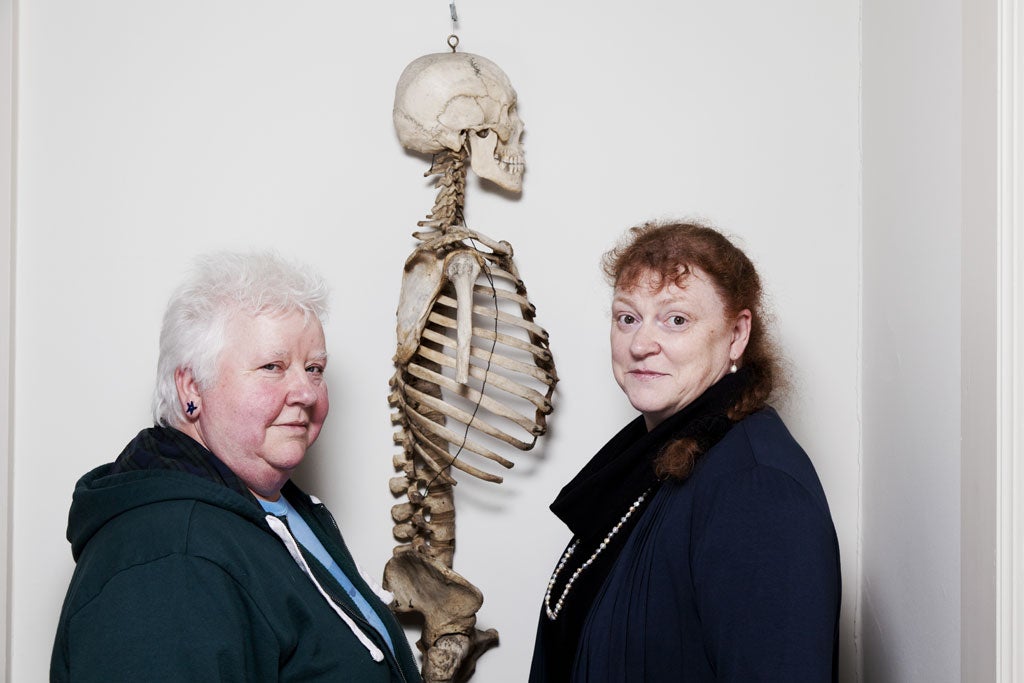How We Met: Val McDermid & Professor Sue Black
'We always find something to giggle about. We're like schoolgirls, but with gallows humour'

Professor Sue Black, 50
A professor of Anatomy and Forensic Anthropology at the University of Dundee, the work done by Black (right in picture) has led the way in human identification in conflict zones such as Kosovo. She also appeared in BBC2 factual series 'History Cold Case'. She lives in Stonehaven, Aberdeenshire, with her husband.
I don't read crime novels – it'd be like a chef watching food programmes – so I didn't know much about Val until I was asked to do a radio programme with her about death and dying, in the late 1990s. We were chatting away before we went on air when I made the mistake of saying, "If at any point in the future you need to ask me about anything, feel free." You make one offer and she's in there.
The woman is the most psychologically disturbed person I've met and her requests are ridiculous. Weeks later she called me up, saying: "I hope you don't mind but [in this plot] I have a body and I need it to be found six weeks after death, and the following has to have happened to it..." For me it becomes almost like a crossword puzzle – it's great fun working out the details [of how things might have happened] for her.
The friendship was the easy part – we have the same warped sense of humour – but for an academic and novelist to trust one another in this world is quite something: I trust her enough to know that the cases that might go into her book are never recognisable: she's just looking for snippets of detail that she can weave in, in her own way.
I like that she's just as comfortable talking about frivolous things as things that have had a big impact on me. So one minute we'll be sitting in a café trying to recreate a gory scenario – she'll be like, "How can I get two individuals together then create massive amounts of blood?" and I'll say, "If you're looking for spectacular blood flow, you'll need to cut the carotid arteries, best if you can have them doing physical exercise, then open up that artery and it will spray!" – then her tone changes and she'll say, "Tell me about the Kosovan [mass graves]."
I've never been paid for giving Val this sort of info – she's never even bought me a drink – but she knows that her books are realistic because of people like me, so when my university needed a new mortuary, she got in touch with her crime-writer friends to help us to raise money with the Million for a Morgue campaign. And it's sufficiently mad that it may just work.
Val McDermid, 56
A best-selling crime writer, McDermid is most famous for her Dr Tony Hill series, which was adapted for TV as 'Wire in the Blood'. She divides her time between Northumberland and Manchester.
After a radio show we did together about 15 years ago, Sue said that if ever she could help me, I shouldn't hesitate to get in touch. And due to her forensic specialism in bones, I did. It was 1996, when I was working on [my novel] The Wire in the Blood. In the book, an arm had been preserved from a murder 15 years previously and I wanted to know what advances in medicine were made in that time that could be applied to the bone. She said, straight away, "Backscatter electron microscopy," and I was like, what? She was extraordinarily helpful.
Sometimes when you talk to scientists their minds run on train tracks; you speak to them about one thing and that's all they talk about. But with Sue we chat for hours, far and wide, with ideas that have taken me in all sorts of directions.
She has a great knack for expressing things that a lay person like me can understand. I was researching a book called The Grave Tattoo and I needed to know what a body would look like that had been in a peat bog for 200 years. So I rang her up and she said, "It would look like a leather bag with a face on." And that image is right there in the book.
Sue has a great respect for the dead and the dignity that she inculcates in her students is palpable; there's not going to be anyone in Sue's lab doing silly things with dead bodies. After 50 years on the planet, you do get blasé about a lot of things, but when Sue showed me around her anatomy lab several years ago it gave me a revived sense wonder about what goes on in the human body . There's something extraordinarily moving about being alone with the corpses of people who have left their bodies to science.
She's a huge figure in her field and most of the time people expect a certain gravitas from her – and when it comes to professional matters, she has it. But she enjoys life and we're always finding something funny to giggle about; we're like schoolgirls, but with gallows humour. One Sunday we were sitting in a hotel lounge, having coffee, biscuits, and a very animated discussion about the goriest of forensic scenarios. When we looked up we realised the people nearby were inching away, horrified...
Million for a Morgue runs until the end of 2012. For more: millionforamorgue.com
Join our commenting forum
Join thought-provoking conversations, follow other Independent readers and see their replies
Comments